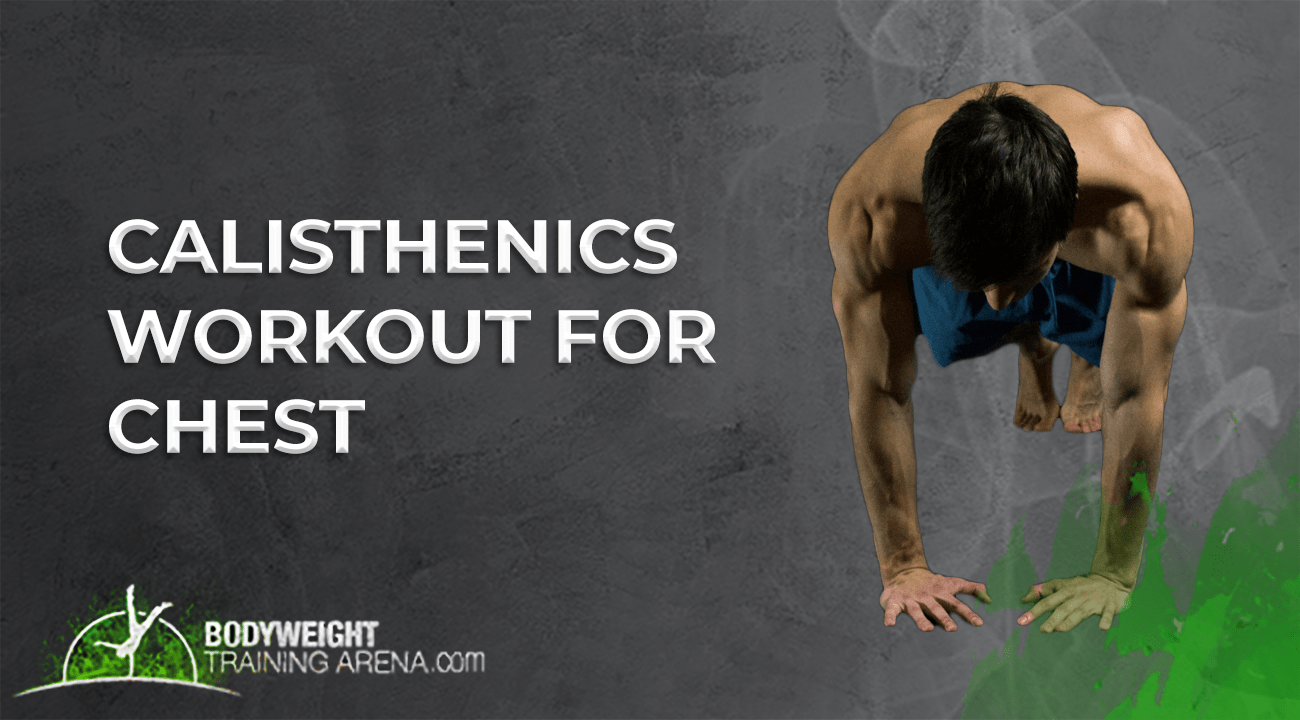
Join the tribe of Movement & Calisthenics Athlete - people just like you that are working with their own body weight to get strength, lose fat build muscle, recover from injuries and live their best lives!
Having a strong chest (pectoral muscles) is one of the most desirable physical traits there is (especially for men).
Due to the mainstream media, bigger and stronger chest muscles are usually just associated with weight lifting.
What if I tell you that you can build strong pectorals with calisthenics alone!
In this article, we’ll cover some of the best exercises to develop your chest as well as a sample of calisthenics chest workout you can do to beef up your chest game.
Debunking a common myth:
Weights only = bigger, stronger chest
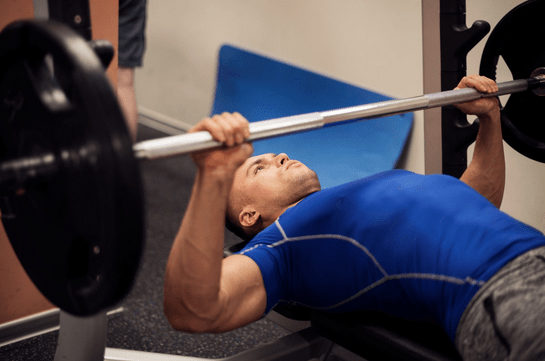
Your trusty barbell bench press exercise. Photo from gpointstudio of Freepik
It becomes really obvious when you set foot in a public gym or weight room. You’ve surely seen guys (& gals) constantly bench pressing day after day after day after day.
We can’t argue how effective the ever-popular bench press is to develop your chest muscles. Studies show the bench and the dumbbell flies are proven chest exercises for strength and muscle growth.
Unfortunately, this approach (constantly training your chest with weights, especially the bench press), combined with poor form (going for quantity rather than quality) poses a high risk of serious shoulder & elbow injuries down the road.
I know this all from personal experience, which is why I’d like to help you avoid the same mistakes and frustration with this simple guide to chest development using bodyweight training.
You don’t have to rely on weights.
It can be done by using bodyweight exercises that are adaptable to suit any and all experience levels. Keep reading to learn about the top bodyweight chest exercises. We’ve included some movements specifically for each level of athlete wherever you are in your calisthenics journey; beginner to advanced.
Principles for Bigger and Stronger Chest Muscle
There are three major factors that facilitate growth for bigger and stronger muscles in general:
- Stimulating workout through “progressive overload”
- Proper nutrition through meeting the caloric needs and nutrients needed (primarily protein)
- Good recovery with high-quality sleep and stress management
Stimulating workout
Most individuals who can’t grow their chest with calisthenics aren’t doing PROGRESSIVE CALISTHENICS.
This means using the right “progressions” or specific exercises with the right intensity for his/her current skill level to stimulate growth. And to keep growing, you need to continually make each session harder.
Read more: How to Build Insane Muscle Mass Using Only Your Bodyweight
Best Calisthenics Exercises
For all levels (scalable)
I’ve included exercises that can easily be modified or altered to become easier or even more difficult for each of these movements.
As always, I personally have experienced great success using each and every one of these exercises and made tremendous strength gains using them.
Enjoy!
Rings Chest Flies
Daniel Vadnal of FitnessFAQs’ excellent explanation on ring flies
Bodyweight Ring Flies are hands down the best way to replicate weighted flies without a doubt. Actually, these are even better because doing them on or with rings adds another degree of freedom into the picture. This extra movement brings your stabilizing muscles and even your core into the equation which is why it is number one by a mile.
Think of this exercise like a chest “isolation” exercise. This is why it works so well at targeting your pectoralis major!
Obviously, you will need gymnastics rings or a TRX system and something to hang either of those from. Once you’ve done that, assume a standard push-up position on the rings (see the video for complete instruction).
Instead of simply performing a push-up, spread your arms out to the side like a “fly”, and then, using your pectoral muscles, push your way back up to the starting position.
If this is too hard at first, you can easily alter the movement by starting on your knees in the modified push-up position or perform with your upper body in a more vertical manner.
If they become too easy (congratulations!), you can try elevating your feet onto a box or bench to increase the level of difficulty. Or you could also pause at the bottom of the movement for 2-3s which would also add difficulty.
BandPush-ups
Dr. Surdyka of E3 Rehab explaining how to set up the band push-ups and the benefits you can gain from it.
One of the major criticisms of calisthenics chest workout compared to bench pressing is that you can’t easily simulate the load of the bench press.
To that, I say “can’t” never did anything.
With quality resistance bands, and your own bodyweight you can most definitely use a regular push-up to stimulate the same muscle fibers bench press does.
To start, get ready to assume a normal push-up position, with a resistance band placed around your back so that it falls right over the middle part of your shoulder blades (see video).
Next, take the ends of the band and place them firmly under your hands as you get into a push-up position. Then continue doing push-ups as you normally would.
In the gym, you might see people adding plate weights on top of their back to obtain the same effect. Do not try this! Using bands is much, much safer and eliminates the risk of a big metal plate hitting you in the head!
There are also variations to this exercise, where you can place the band over your waist, or under your chest, depending on the level of challenge you want to give your body.
Chest dips
Jeff Nippard demonstrating how to perform chest dips and other possible variations and progressions.
For this one, you’ll obviously need a dip station or parallel bars. If you don’t have one, don’t worry. You can still train the exercises with two sturdy chairs placed near each other. Just keep in mind that you can find alternatives for some equipment.
You’re probably familiar with the triceps dip, but I bet that you don’t know the Chest Dip exercise.
A ton of people who THINK they’re doing a triceps dip are actually doing a Chest Dip. Basically, this variation is the same thing as a triceps dip, but you angle your torso (body). To do this, just lean forward with your upper body (roughly 30 degrees) over your feet (see video).
This change in body position switches the workload from the triceps, which would be worked more in a straight up and down movement, to the chest.
You will definitely notice the difference in “feel” between the two movements once you start. On the chest dip, you should really feel your chest muscles stretch in the bottom position similar to a chest fly.
To make the movement more difficult you can always add weights (via a weight belt) or by adding isometric holds (2-5 seconds) in the bottom position.
There are also simpler variations, as demonstrated in the video; you can for example add a chair to raise your body in order to focus the exercise on lowering yourself down in the beginning.
For Beginner Calisthenics Athlete
For those of you who are just starting out with bodyweight training, don’t worry! The great part about bodyweight training is the ability to easily modify the movements so that beginners can build up their strength and work their way up to the full movement.
Below are three excellent movements that beginners should focus on to advance their way to the full movements.
Inclined push-ups
Adby twins of Train with Adby demonstrating the best push-up variation for beginners!
For individuals starting as a complete beginner or you have relatively lower strength levels, your calisthenics journey begins here with the incline push-ups.
This exercise is great for developing your upper and lower chest while also teaching the proper form, technique, and strength foundations for the future’s calisthenics chest workout set.
Begin with a higher level of inclination. As you get stronger, move lower until you’re on standard floor push-ups.
From there, you can play with decline push-up, move to other variations like push up hold or diamond shape push-ups.
Assisted dips
Charles Vassalo of JazzOCRAthlete introducing the assisted dips with bands.
You can begin your journey towards growing a bigger chest with assisted dips. You can use your legs or a good rest of resistance bands to do the trick.
For leg-assisted dips, you can place an elevated surface behind you to place your legs on. Or you can also just place your feet on the ground but minimize the assistance from your lower body and focus on doing the dip motion from your chest.
If you’re using bands you’d simply tie the ends to the handles where you place your hands. Then you would bend your knees and place the band under your ankles so that it helps push you up as you perform the exercise.
Note: If you’re using bands to assist you, please use extreme caution. Make sure the band is of high quality and is not going to break on you potentially causing injury. If possible have a partner with you to help you get into the proper position and spot you.
For Intermediate Calisthenics Athlete
There are also exercises for the more experienced individuals but who are not technically on the advanced side of things.
When working with these variations, be sure you have at least mastered the basic movement patterns of pushing such as regular push-ups and dips.
Ring Push-ups
Daniel Vadnal of FitnessFAQs again with a piece of excellent information on how to maximize chest activation during the ring push-up.
Can’t feel your pectoralis major working when doing push-ups on the floor?
Then try them out again but don’t gymnastics rings this time.
Just from the starting position, you’ll immediately recognize the added stimulation on your chest just to hold the position.
To begin, go into a push-up position with hands shoulder-width apart on the rings with your arms turned out. The key here is to always go back to the arms straight and turned out position after each rep.
Move the same way as a regular push-up but we guarantee the challenge you will face on rings for sure!
Ring dips
A detailed guide from Sid Paulson on the basic ring dip movement.
These are exactly the same as the chest dips in the top overall exercises section (#3). The only difference is that you will obviously be performing them on rings.
The rings add the possibility of more movement, which adds another level of difficulty. You will not only be working your chest but also your body’s stabilizing muscles (core) which is what makes this movement a complete upper body exercise.
Make sure that you set the rings far enough apart so that the straps are not rubbing or even touching your forearms as you move up and down. Having them touch your arms eliminates the lateral freedom of movement, removing the purpose of the gymnastics rings.
You can finish each rep with our regular ring support hold but it’s highly encouraged to end with the Rings Turned Out (RTO). This means turning out hands outwards until your palms are facing forward and arms locked out straight. This adds a ton of tension to your elbows, bicep, and chest which is great for stronger muscles!
Archer push-ups
Victory Calisthenics teaching the proper archer push-up technique.
Archer push-ups are part of the one-arm push-up progression. This is a unilateral exercise which means you train one side at a time, excellent for fixing any strength imbalances.
The aim of the exercise is to make one side work more while the other holds just for assistance. Your goal is to make your non-working arm as straight as possible to minimize assistance as you get stronger.
For Advanced Calisthenics Athlete
Individuals who pose a higher level of strength can still benefit from the dips and push-ups but, again, modifications must be made.
Rings still offer a reliable increase in the level of difficulty of our base exercises.
Ring Bulgarian dips
JT from bodyweight strength’s tutorial on Bulgarian/wide ring dips.
Rings dips feel easy? Try moving towards this wider variation.
The beginning motion is the same as a regular ring dip with the RTO support hold. As you begin to lower your body, turn your arms inwards until your palms are facing backward and simultaneously moving the rings away from the body. Lower until your elbows are at or a bit past 90 degrees. Squeeze your chest to push back up to the RTO support hold.
The motions of the Bulgarian dip put additional instability and maximizes the stretch and reflex of the chest which is great for more stimulation.
If you’re also interested in more advanced calisthenic skills such as the iron cross, Bulgarian dips have a direct transfer that prepares you for such an advanced skill.
Ring Archer push-ups
Bodyweight Warrior’s Tom Merrick on archer push-ups on rings.
A complete list of the best calisthenics chest exercises isn’t complete if it doesn’t have the ring archer push-ups!
The is a great calisthenics chest exercise by adding instability and working on one side of the muscle group per rep which fixes any imbalances.
The intent is to make the act of raising one arm appear as if it’s done gradually, whereas the other arm is steadily tucked in close by your side and resembles an archer aiming and prepared to fire an arrow at his target.
Think of pushing the arm closer to you and pulling the straight arm simultaneously as you return up.
When first beginning, you can position the rings higher as if doing an incline push-up. Aim to lower the rings until your full body is parallel to the ground.
Always lock up with arms straight at the top position for each rep to maximize chest activation.
Weighted calisthenics variations
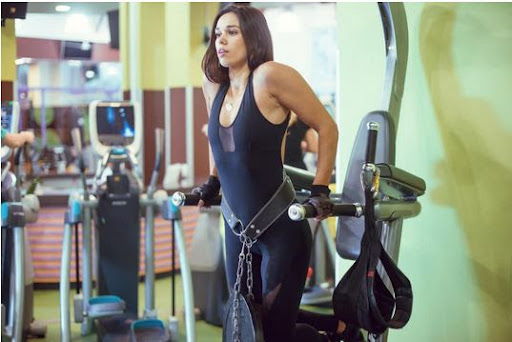
We just have to include any variation of the exercises above with added weights.
Although it’s not technically purely bodyweight, the exercises are still calisthenics in essence and the added weight just increases the intensity further.
Whether it’s for the pull-ups, push-ups, dips, weighted variations are excellent options for increasing your absolute general pushing (or pulling) strength. This means you also get to be a lot stronger for advanced calisthenics skill work.
For any weighted variation, we recommend getting a dip belt. You can use them for your push-ups, pull-ups, and dips (obviously!).
Read more: How to Use Weighted Calisthenics for Ultimate Strength Gains
Advanced honorable mentions
We already talked about the best exercises that specifically target the chest.
The exercises below are great hits the chest but also targets many muscle groups heavily which is why you might get fatigued first before reaching enough training volume for your calisthenics chest workout.
Keep in mind that the exercises that are not on the list AREN’T BAD. They just don’t train your chest as efficiently and effectively as the best calisthenics chest exercises mentioned.
One-arm push-up
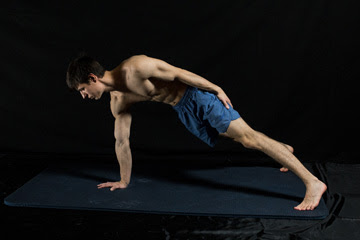
Movement Athlete coach at a one-arm push-up starting position.
Working with a single arm places your full body in instability. This causes your shoulders, triceps, and core to work extra hard to keep you stabilized.
Planche push-ups
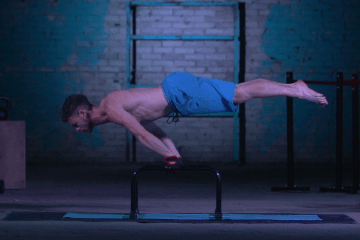
A Movement Athlete coach at the top position of a full planche push-up.
Any planche push-up progression hits the chest hard. But the demand on the front deltoids is much harder to be able to stimulate the chest enough before fatiguing.
Individuals opting for this exercise to train the chest are usually more advanced or can opt for other chest movement patterns mentioned above.
Iron cross
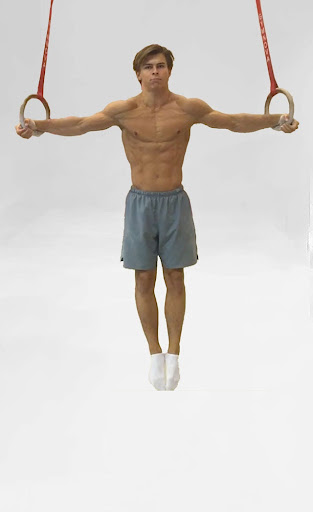
Elite gymnast, William Broman, displaying raw strength through the isometric iron cross.
Finally, the granddaddy of all bodyweight exercises. In my opinion, the iron cross is the ultimate bodyweight feat of strength. The numero uno way of proving just how badass and strong you are.
The demands on the chest are high, but you would need stronger stabilizer muscles and shoulders before you can even attempt to move. This exercise is more reserved for advanced strength-based skill work.
CHEST Calisthenics Workout ROUTINE
Warm-ups are important for EVERYONE
Now, even though you’ll be training completely with bodyweight using these exercises, I cannot overstate how important a thorough warm-up is.
Five to ten minutes of alternating between the warm-ups below in circuit fashion should definitely have you ready to train!
- Arm Circles
- Push-Up
- Band or Broomstick Shoulder Dislocations
- Band Pull Aparts
CALISTHENICS CHEST WORKOUT
90-second rest in between sets and exercises
Exercise 1: Dip variation – 4 sets of 6 – 10 reps
Exercise 2: Push-up variation – 4 sets of 8 – 12 reps
Exercise 3: Chest fly variation – 3 sets of 8 – 12 reps
“BUT I CAN’T DO SOME OF THESE EXERCISES AND REACH THE VOLUME!”
Cookie-cutter approach and lack of personalization are hurting your results. It’s a FACT.
Imagine if some of these exercises above were too hard for you. Your body will try to compensate through poor form, movement dysfunction and possibly risk injury if it’s too challenging. And now imagine if some of these exercises were so easy they didn’t challenge your muscles to grow – you’d simply be wasting your time. This is why we created The Movement Athlete platform: to offer a fully personalized training program reflecting exactly where your level is for optimal performance.
Take the assessment to see how do you stack up on the 8 fundamental calisthenics moves
Share the results and comments in our Facebook Group

